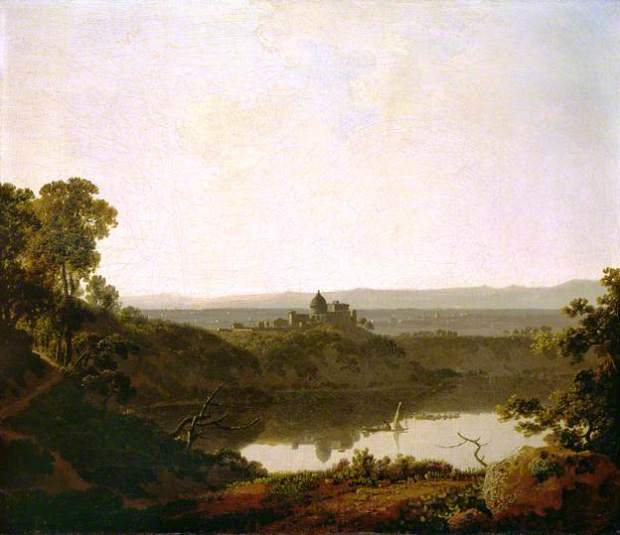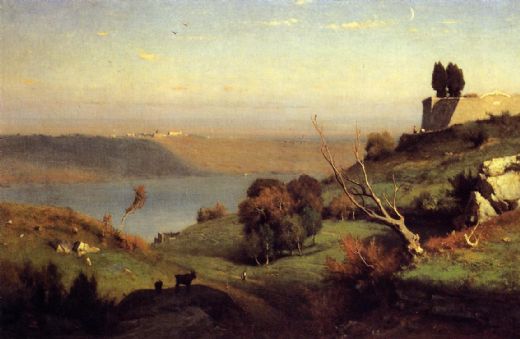John Robert Cozens the18th century British painter of romantic watercolour landscapes often visited Italy finding the tranquil vistas, and that of Castel Gandolfo in particular, inspirational to his work. Although John Constable considered him “the greatest genius that ever touched landscape” his work was rejected by the Royal Academy, no doubt contributing to the nervous breakdown which eventually led to his hospitalization at the Bethlem Royal Hospital Asylum. In June 2010 Cozen’s Lake Albano (c.1777) sold at a Sotheby’s auction in London to David Thomson the Canadian media tycoon for £2.4 million, a record for any 18th-century British watercolour and quadruple its estimated price.
The above detail of Francis Towne‘s panorama (1781) is a lovely example of a watercolour-tinted drawing: soft tints of colour are layered over the dark ink wash with the details picked up in pen and ink to sharpen and highlight the details of the foreground. Unlike Cozens, who inspired William Turner and other English contemporaries, Towne’s more lithographic and antiquated style seems to have had little influence (apart from perhaps John Varley and John Sell Cotman) on the succeeding generation of romantic artists. His elegant loose drawing style and almost abstract wash designs nonetheless convey the serenity and warmth of the region of Lazio.
 Self-taught landscape and portrait painter Joseph Wright of Derby is best known for his canvases capturing the spirit of the Industrial Revolution. Some twenty years after Cozens, he must also have felt the call of warmer climes and the less frantic pace of the countryside surrounding Castel Gandolfo. Although a frequent contributor to exhibitions at the Royal Academy, he declined becoming a full member due to a slight he believed had been directed at him by members.
Self-taught landscape and portrait painter Joseph Wright of Derby is best known for his canvases capturing the spirit of the Industrial Revolution. Some twenty years after Cozens, he must also have felt the call of warmer climes and the less frantic pace of the countryside surrounding Castel Gandolfo. Although a frequent contributor to exhibitions at the Royal Academy, he declined becoming a full member due to a slight he believed had been directed at him by members.
Like many other French painters of the early 19th Century, Jean-Baptiste-Camille Corot journeyed to Italy in 1825 to refine his skills. He was extraordinarily productive completing over 200 drawings and 150 paintings during his three-year stay. Corot made two return visits to the country where he had been so prolific and each time returned to the same spot to capture once again the scenery of that had so entranced him as a novice.
The American painter George Inness spent almost eight years in Italy in the 1870s perfecting his picturesque and panoramic style. Influenced by the old Masters, Nicolas Poussin, and the Hudson River and Barbizon Schools, his paintings are meticulously composed, saturated with colour and include precise detail. The wide open skies and views from the hillsides surrounding Lake Albano seem to have nurtured his predilection for the theology of Emanuel Swedenborg for upon his return to America his work became infused with a more abstract, mystical component. Inness died in 1894 in Scotland where, according to his son, he was enjoying the setting sun when all of a sudden he threw his hands into the air with the exclamation “My God! oh, how beautiful!”, upon which he fell to the ground and passed away minutes later.
A multitude of artists, past and present, famous and unknown, have set up their easels and balanced sketchbooks on their knees to capture Lake Albano and Castel Gandolfo – though the details of the landscape may change with the passing of the years and man though managed encroaches, its beauty like the art it inspired remains timeless.
Read more on Landscape Art here…








You can just get lost in these paintings!
LikeLike
Looks like a lovely travel destination as well!
LikeLike
This was good- we need to see more paintings!
LikeLike
Glad to oblige!
LikeLike
Yes please!
LikeLike
Wonderful!!!!
LikeLike